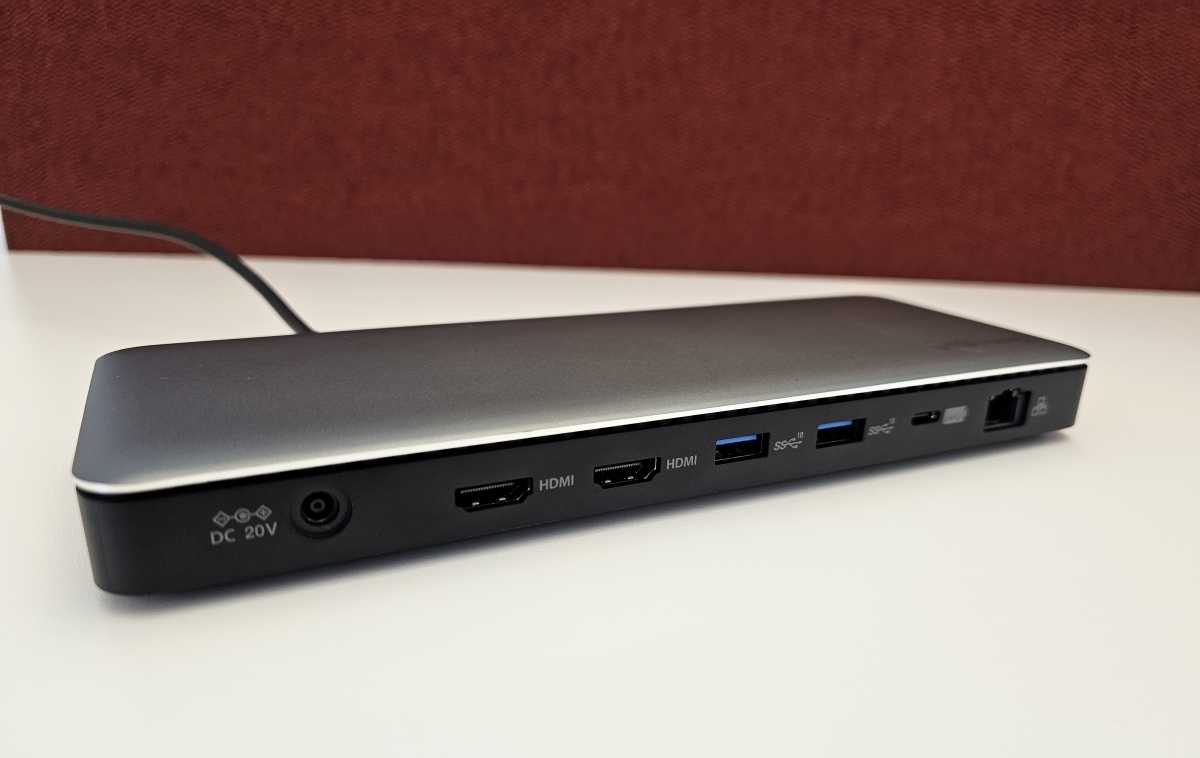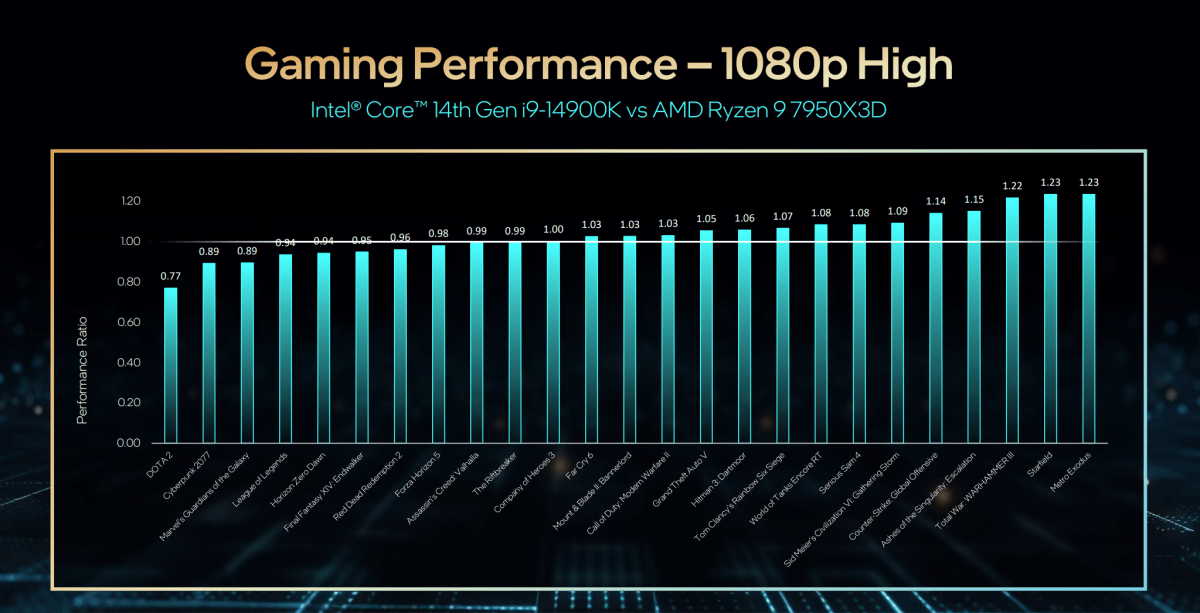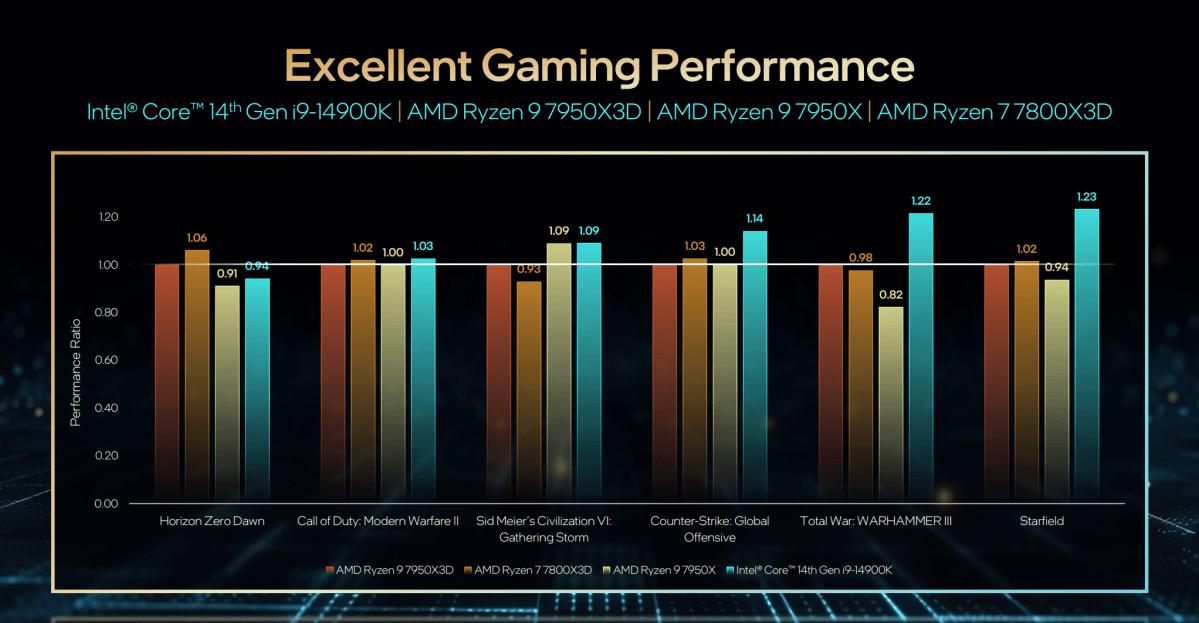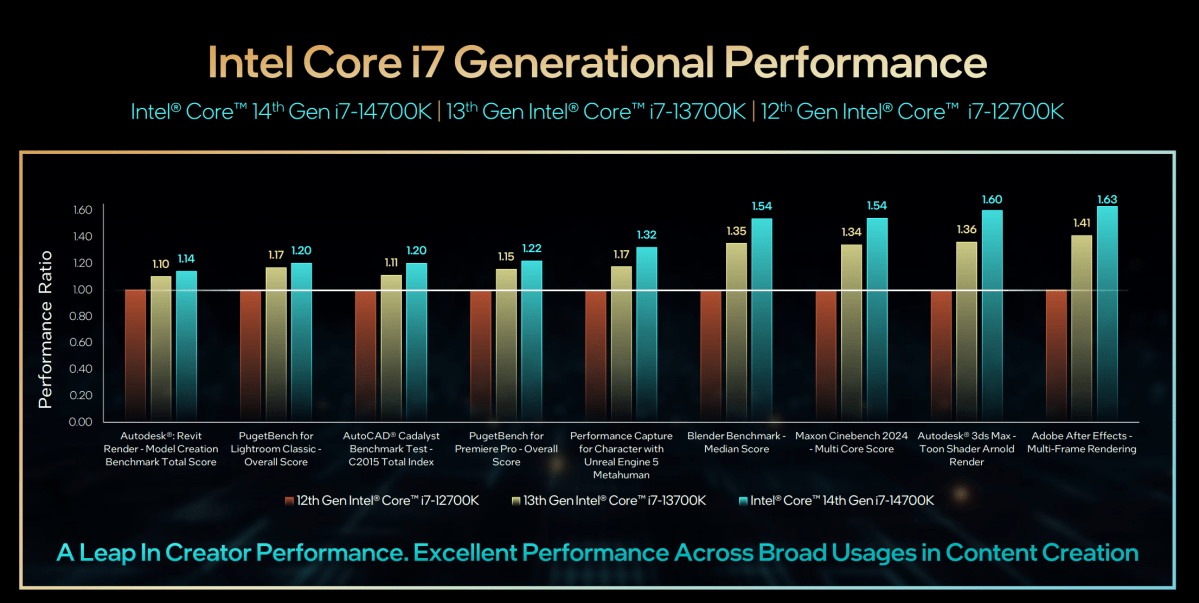Intel’s latest 14th-gen Core desktop processors, “Raptor Lake Refresh,” do away with the AI NPU and complex tiling system inside the recent 14th-gen “Meteor Lake” mobile chips. But AI is being used here, specifically to assist what gamers care about: improving game performance and CPU clock speeds.
As expected, Intel’s “refreshed” Raptor Lake chips offer modest performance improvements over their predecessors, while ushering in eventual platform upgrades like Thunderbolt 5. But there are boosts, such as a tweaked Intel 7 process that pushes turbo clock speeds up to 6GHz with the new Core i9-14900K and a new “Application Performance Optimization (APO)” feature that appears to optimize the CPU for a particular game.
But — and this is important, given inflation — Intel is holding pricing (almost) steady. Prices in Intel’s 14th-gen Core desktop S-series line will range from $589 for the 24-core, 32-thread Core i9-14900K down to the $294 14-core, 20-thread Core i5-1400KF, for a total of six new processors. This is the third straight generation in which Intel has left its processor prices virtually unchanged, including the 13th-gen Raptor Lake and the 12th-gen Alder Lake chip, whose slowest chip was priced at $264.
Perhaps not surprisingly, Intel’s not offering many direct generation-over-generation comparisons with its own processors, though it selected a few content-creation benchmarks to highlight with its Core i7-14700K. There, performance improvements range from 3 percent (Adobe Lightroom) to 18 percent (Autodesk). According to Roger Chandler, vice president and general manager of Intel’s enthusiast PC and workstation business, the Core i7 features the best multithreaded performance on a Core i7 ever.
Intel executives said the chipmaker had about 130 partners and customers for the 13th-gen launch, and expect the same for the debut of the 14th-gen Raptor Lake Refresh chips.
Intel’s 14th-gen Core desktop: Slight speed, core count increases
Like Raptor Lake, Intel’s Raptor Lake Refresh is an Intel 7 chip. Otherwise, it’s the same. Raptor Lake Refresh uses the same die and revision as Raptor Lake; the only difference is the core count.
However, Intel has “optimized and refined both our silicon and our process, which has enabled us to get higher frequencies out of the box,” Aarohi Patel, an Intel product marketing engineer, said during a press briefing.
Here’s a short summary of the new 14th-gen desktop Core processors. The slightly cheaper -F variants forego the integrated GPU for those customers who plan to use a discrete GPU anyway. All of the new these new 14th-gen Core chips run at a processor base power of 125W.
- Core i9-14900K (8 P-cores, 3.2GHz/5.6GHz; 16 E-cores, 2.4GHz/4.4GHz): $589, $564 for -F variant
- Core i7-14700K (8 P-cores, 3.4GHz/5.5GHz; 12 E-cores, 2.5GHz/5.5GHz): $409, $384 for -F variant
- Core i5-14600K (6 P-cores, 3.5GHz/5.3GHz; 8 E-cores, 2.6GHz/4.0GHz): $319, $294 for -F variant
Both the 14th-gen Core i9 and Core i7 processors improve over the 13th generation, albeit in different ways. All of the Raptor Lake Refresh chips include the same UHD 770 integrated GPU as the prior generation.
It’s not surprising that Intel selected the Core i7-14700K as a point of comparison, as that chip shows the most marked architectural improvements over the 13th-gen Alder Lake. (“It was where we had the biggest opportunity to add additional cores, so we did,” Chandler said.)
The Core i9-14900K/F remains unchanged at 24 cores and 32 threads; so does the Core i5-14600K, at 14 cores and 20 threads. The new 14th-gen Core i7-14700K/F, however, includes 20 cores and 28 threads. That’s a bonus compared to the 13th-gen Core i7-13700K/F, which built in 16 cores and 24 threads. All of the new Core i7-14700K/F cores are E-cores.
But the Core i9-14900K/F are the only two chips with an increased clock speed compared to their 13th-gen counterparts: The Core i9-14900K’s P-core clock speed increased from 3.0GHz to 3.2GHz, while the E-core frequency increased from 2.2GHz to 2.4GHz.
Here’s an Intel-supplied diagram of the six new 14th-generation Raptor Lake Refresh processors with additional detail.
Intel
Remember, Turbo Boost Max Technology 3.0 identifies the processor’s fastest cores and routes tasks to them, especially very specific single-threaded jobs. Intel Thermal Velocity Boost can apply 100MHz of additional boost clock if the chip’s thermal tolerance can take it — for example, if your PC was shut down overnight and has just booted. It’s a “bursty” feature, though, so it will quickly turn on and turn off.
As noted above, the PL1 state (or the amount of power the chip consumes normally) is 125W. In its turbo/boost or PL2 state, the chip consumes 253W, the same as Alder Lake.
Platform improvements are on the way
These new 14th-gen Raptor Lake Refresh chips will be backwards compatible with existing 600- and 700-series motherboards, so you should be able to slot them into existing motherboards with minimal changes, besides the usual BIOS updates. “Generally, it should be a seamless upgrade,” Chandler said.
However, Intel’s Chandler identified two key forthcoming additions to the 14th-gen platform: Wi-Fi 7, and Thunderbolt 5. Wi-Fi 7 will enable wireless speeds that exceed wired throughput at over 40Gbps, and the first Wi-Fi 7 (802.11be) routers are already rolling out. (It’s worth noting that Wi-Fi 7 is still a “draft” standard, which hasn’t been totally ratified, so this is a slightly risky purchase.) Specifically, Wi-Fi 6e will be integrated, while motherboard makers who wish to add Wi-Fi 7 options can do so but with a discrete component. (Ditto for Bluetooth; Bluetooth 5.3 is integrated, while Bluetooth 5.4, which offers improved one-to-many communications features, requires a discrete chip.) Intel will be using its “Killer” branding on these.
Thunderbolt 5 isn’t quite here yet, either, but it too will offer speeds in excess of 80Gbps — and even up to 120Gbps — potentially replacing HDMI and DisplayPort display connectors, and connecting to external SSDs and graphics cards. It’s expected to debut in 2024, however, after the first 14th-gen desktop systems have shipped.

Mark Hachman / IDG
What’s interesting is that Intel apparently expects 20Gbps USB 3.2 (Gen 2×2) to go mainstream as well. Though Intel introduced this feature with Raptor Lake, it’s still a relative rarity: USB-C ports usually offer 10Gbps and that’s it. Why should you care about 20Gbps USB-C? Because that’s pretty much the standard for external gaming SSDs, which can be a very attractive product to buy if your gaming rig has ever run out of space on the main drive.
Memory support remains for both DDR4 and DDR5, with up to DDR5-5600 and DDR4-3200 support for the Core i5, i7, and i9 products, an Intel spokesman said via email.
Perhaps the most intriguing addition, though, is what Intel calls Application Performance Optimization, or APO. Remember Intel’s Dynamic Tuning Technology? That 2018 technology dynamically juggled power between the CPU and the GPU, to eke out as much performance as possible. APO sits within that framework, according to Intel, and alongside the Thread Director technology that assigns tasks to the E-cores and P-cores. (Unlike Meteor Lake, Thread Director returns to the habit of assigning new tasks to the P-cores as it did in Raptor Lake, incidentally.) Intel refers to APO as a “scheduling policy.”
What’s the difference? It’s a bit vague. APO can “detect exact application instantiation, and direct and control the thread type,” according to Patel. Thread Director operates at a higher level, taking direction from the operating system.
Here’s the bottom line: APO is essentially like a GPU driver upgrade for the CPU, allowing what executives called a “nice performance bump” in games like Metro: Exodus (16 percent increase) and Rainbow Six: Siege (13 percent increase), according to Chandler. While it’s enabled by default, it can be disabled, though it’s not clear what benefits you’d see from doing that.
Intel executives said that there aren’t any negative effects from turning on APO. Unfortunately, it’s being tuned for specific games, and not non-gaming applications like Photoshop. (That could happen, but there are no guarantees.) It will also need specific support from Intel, so games just won’t be enhanced by default. “We see this as an opportunity to actually boost the performance for individual games without having an overall performance impact on other applications,” Chandler said.
Oh, and APO won’t work with benchmarks, either — or if you or someone else changes the name of the executable file, Chandler said.
Intel 14th-gen desktop performance: Don’t expect too much
Since this is “Raptor Lake Refresh,” there aren’t any architectural improvements; the design of the chips remains the same, so any improvements arrive just in improved clock speed. That means that performance improvements should be minimal.

Intel
“There is no architecture change,” Patel said. “So the IPC [instructions per clock] is exactly similar to what we had before.”
Intel, surprisingly, did not release gen-over-gen comparisons for any games played on the 14th-gen Core. According to Chandler, the improvement would be in the “mid single digit, maybe upper single digit” range, excluding the effects of APO. Instead, Intel focused on comparisons to the competition, AMD, and tried to show the starker demarcation between its 12th- and 14th-gen processors instead.

Intel
Intel also supplied its own evaluation of how its 14th-gen Core i9-14900K compares to the AMD Ryzen 9 7950X3D, with modest improvements across the board. It did the same with a selection of Ryzen 9X and 9X3D chips, as well.
As far as the generational improvements are concerned, Intel limited them to the slide seen below. There’s always a certain amount of cherry-picking that goes on with benchmarks, but this looks pretty specific.
Although Intel didn’t directly compare the 13th-gen and 14th-gen chips, we can do the math: That’s a 3.6 percent increase in the Autodesk workload on the far left, increasing to 17.6 percent (Autodesk) and 15.6 percent (Adobe After Effects) on the far right. Most of the generational improvements, however, appear much closer.

Intel
Overclocking uses AI as a weapon
With Raptor Lake, Intel continued to tune its Extreme Tuning Utility (XTU), adding one-click overclocking, improved visualizations, and eXtreme Memory Profile 3.0. Now, with Raptor Lake Refresh, XTU is getting personal. Intel is adding what it calls “AI Assist,” where AI meets overclocking. AI Assist is a preview feature within XTU, which can be downloaded from Intel’s site.
AI Assist will essentially scan your system, understanding the individual components, voltages, and power settings and recommending overclocking settings via a “simple step-by-step UI” that are tailored to your system. There is one catch: XTU with AI assist will be offered first for Core i9-14900K/KF processors, with support expanding to other 14th-gen unlocked processors in the future. It will not be added to older chips. (On the other hand, Intel Speed Optimizer will continue to be offered alongside AI Assist, according to Dan Ragland, a principal engineer in Intel’s overclocking lab — which will be the tool 14th-gen Core i7 and i5 buyers can use instead.)
The AI Assist tool was trained by machine learning, inferencing hundreds of CPUs, plus combinations of motherboards, coolers, and even custom liquid cooling. All that is used as a base for its recommendations — though your own experiences may differ, Intel executives said.
Intel is also offering increased overclocking frequencies for P-cores and E-cores, higher DDR5 XMP speeds in excess of 8,000 megatransfers per second, P-core thermal throttling, and a third-party overclocking tool, FoundationTK.com, that’s based on XTU as well.
Ragland, an admitted overclocking enthusiast, said that he preferred XMP 6600 and two DIMMs per channel for pairing with the new Raptor Lake Refresh chips, and buyers will be able to find new XMP modules on Intel’s site at launch. Hopefully, they’ll be as high as XMP 8000, he said.
What’s next?
Is Intel doing anything more than treading water? We’ll have to wait for our own review to see.
However, Intel’s Raptor Lake Refresh doesn’t appear that much more than just that — a refresh — but with some interesting approaches to eking out further performance improvements through AI. Whether or not this leaves the door open for AMD to respond is something we’ll have to learn in the coming months.

